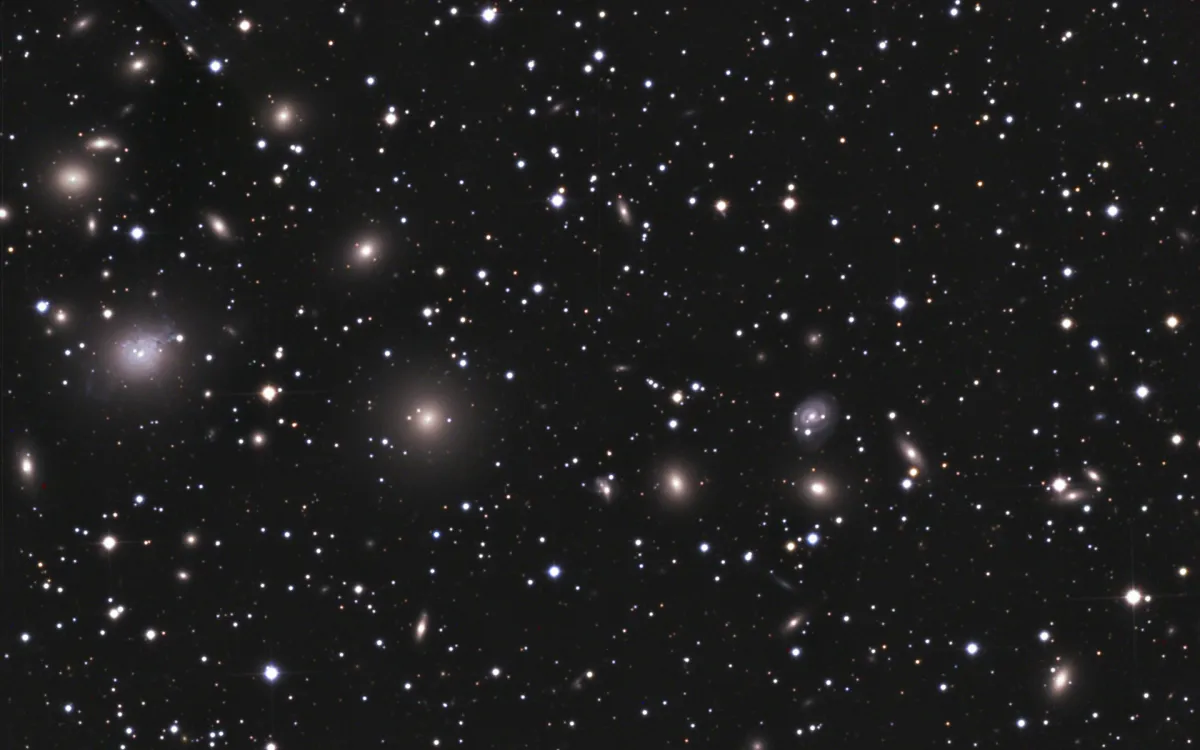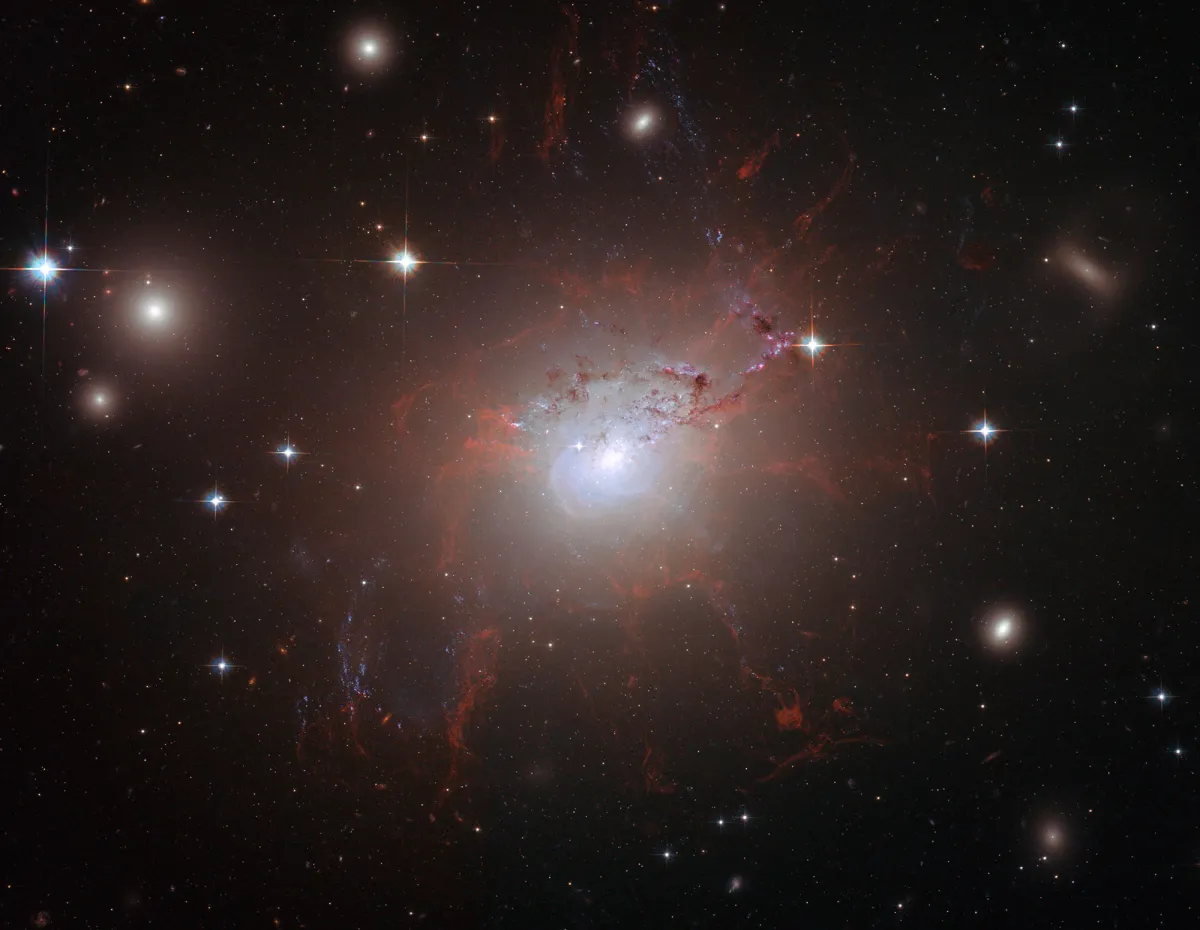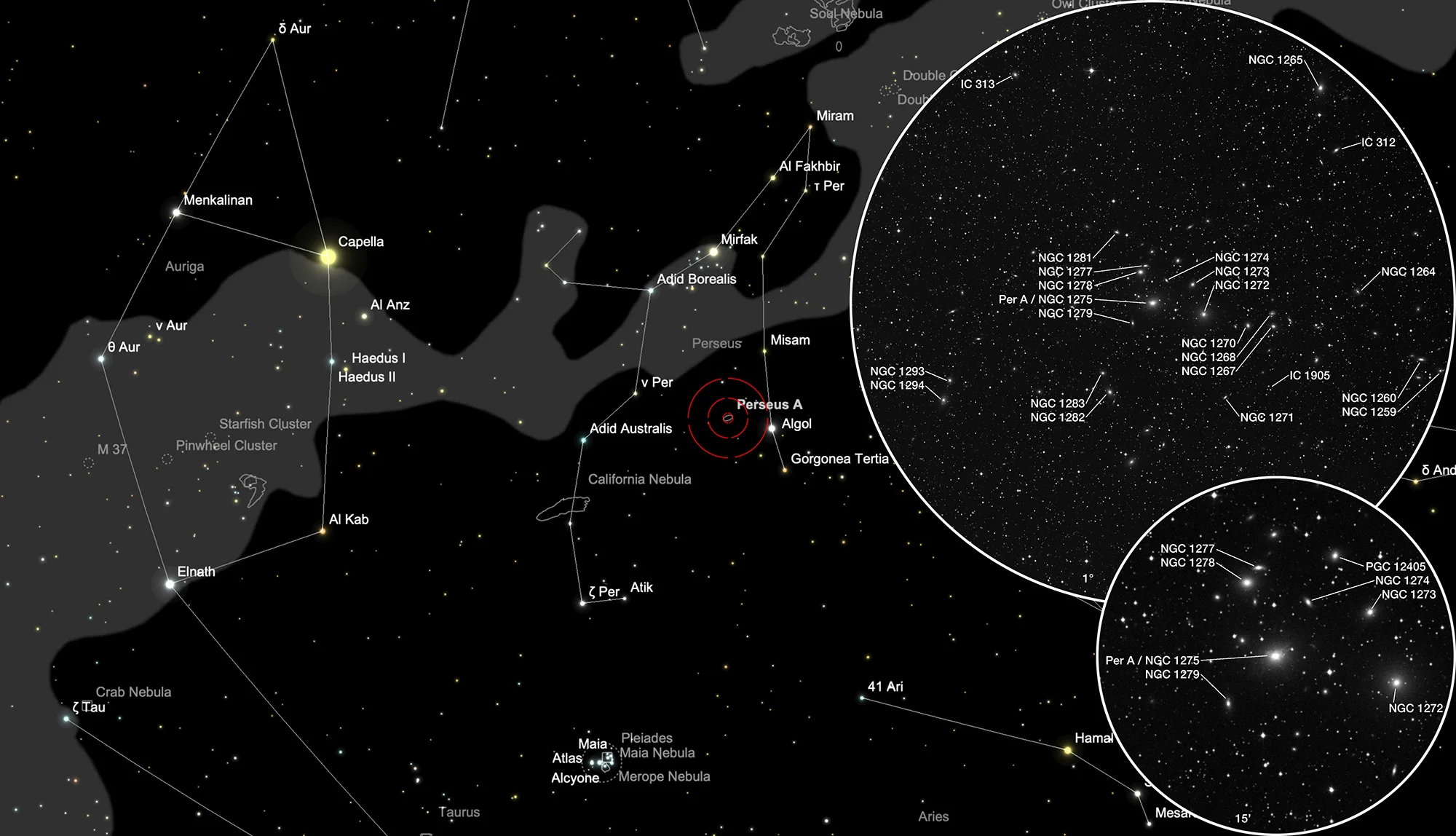Perseus A (NGC 1275) & Perseus Galaxy Cluster


History
On 17 October 1786 William Herschel sweeped the sky using his 18.7 inch reflecting telescope and found an object which he classified as a «faint nebula» and cataloged it as II 603 (NGC 1275) with the remarks: «pretty bright, stellar or pretty considerable stars with small, very faint chevelure.» In the same night he listed two more «very faint nebulae» III 574 (NGC 1293) and III 575 (NGC 1294). He wrote: «Two. Both very faint, stellar, very little brighter in the middle but the southernmost is the brightest and largest.» [464]
John Herschel observed the three nebulae of his father on 18 September 1828 (sweep 182) and measured accurate positions. He listed them in his «Slough Catalogue» as 293, 294 and 295. [466] On 16 December 1848 George Johnstone Stone, assistant at Birr Castle, observed that area using the giant 72 inch reflector of Lord Rosse and noted: «A multitude of nebs. knots in the neighborhood, principally preceding; counted 15; many more.» [364] In the following years many more members joined this group of galaxies: [277]
- Heinrich Ludwig d'Arrest contributed six galaxies (NGC 1267, 1268, 1270, 1272, 1273, 1278) discovered on 14 February 1863 using the 11 inch f/17.5 Merz refractor at Copenhagen Observatory.
- Guillaume Bigourdan found seven galaxies (NGC 1259, 1260, 1264, 1282, 1283, 1265 1271) from 19 October through 14 November 1884 using the 12.4 inch refractor at Paris Observatory. IC 1905 was a misclassification of three close stars.
- Lawrence Parsons, 4th Earl of Rosse found two galaxies (NGC 1274, 1277) on 4 December 1875 using the 72 inch reflector at Birr Castle of his father (Lord Rosse).
- Johann Louis Emil Dreyer found two galaxies (NGC 1279, 1281) on 12th Debember 1876 during his stay at Birr Castle using the 72 inch reflector of Lord Rosse. NGC 1276 is misclassified and a double star.
- Lewis Swift contributed two galaxies (IC 312 and 313) after Dreyer's NGC catalogue was published in 1888. He used the 16 inch refractor at Warner Observatory, Rochester.
The many galaxies in this close group led to some confusions:
- Dreyer mistakenly swapped the entries NGC 1275 and NGC 1278. [313]
- Steinicke lists IC 312 as duplicate entry for NGC 1265 while Simbad assigns IC 312 to the galaxy UGC 2644. [145, 277]
In 1958 George O. Abell published his catalogue of rich clusters of galaxies found on the National Geographic Society Palomar Observatory Sky Survey. NGC 1275 is the brightest member of the Abell Galaxy Cluster 426 (ACO 426). [674]
Physical Properties
NGC 1275 is a giant elliptical galaxy and forms the centre of the Perseus cluster of galaxies (ACO 426), containing around 500-1000 galaxies. It is also associated with the strong radio Perseus A (3C 84).
This galaxy hosts a supermassive, active black hole. Energetic activity of gas swirling near the black hole blows bubbles of material into the surrounding galaxy cluster. Long gaseous filaments stretch out beyond the galaxy, into the multimillion-degree, X-ray-emitting gas that fills the cluster. These filaments are the only visible-light manifestation of the intricate relationship between the central black hole and the surrounding cluster gas. They provide important clues about how giant black holes affect their surrounding environment. The amount of gas contained in a typical thread is around one million times the mass of our own Sun. They are only 200 light-years wide, are often very straight, and extend for up to 20'000 light-years. The filaments are formed when cold gas from the core of the galaxy is dragged out in the wake of the rising bubbles blown by the black hole. Strong magnetic fields hold the charged gas in place and resist the forces that would distort the filaments. This skeletal structure is strong enough to resist gravitational collapse. [261]
Following table lists all galaxies with NGC/IC number in a 1° field of wie around NGC 1275.
| Name | RA | Dec | Type | bMag | vMag | B-V | SB | Dim | PA | z | D(z) | MD | Dreyer Description | Identification, Remarks |
|---|---|---|---|---|---|---|---|---|---|---|---|---|---|---|
| NGC 1259 | 03 17 17.3 | +41 23 08 | Gx (S0) | 15.3 | 14.3 | 1.0 | 13.4 | 0.7 × 0.7 | 0.019400 | 81.94 | 71.940 | vF, S, R, vlbM | MCG 7-7-46 | |
| NGC 1260 | 03 17 27.2 | +41 24 19 | Gx (S0-a) | 14.2 | 13.3 | 0.9 | 12.5 | 1.1 × 0.5 | 86 | 0.019190 | 81.06 | 76.650 | vF, S, R | UGC 2634; MCG 7-7-47; CGCG 540-81; IRAS 03141+4113 |
| NGC 1264 | 03 17 59.5 | +41 31 13 | Gx (SBab) | 14.9 | 14.1 | 0.8 | 13.6 | 1 × 0.5 | 30 | 0.010827 | 45.73 | vF, S, vlbM | UGC 2643; MCG 7-7-50 | |
| NGC 1265 | 03 18 08.4 | +41 45 16 | Gx (E5) | 14.4 | 13.4 | 1.0 | 13.0 | 1 × 0.5 | 125 | 0.016605 | 70.14 | vF, vS, mbM | IC 312; UGC 2644; MCG 7-7-51; CGCG 540-86 | |
| NGC 1267 | 03 18 44.8 | +41 28 03 | Gx (E2) | 14.1 | 13.1 | 1.0 | 13.2 | 1.1 × 0.9 | 30 | 0.016875 | 71.28 | F, vS, R, stell | GC 668; UGC 2657; MCG 7-7-55; CGCG 540-92 | |
| NGC 1268 | 03 18 45.2 | +41 29 21 | Gx (Sb) | 14.2 | 13.4 | 0.8 | 12.7 | 0.9 × 0.6 | 120 | 0.010884 | 45.97 | eF, S, lE, com | GC 669; UGC 2658; MCG 7-7-56; CGCG 540-93 | |
| NGC 1270 | 03 18 58.1 | +41 28 13 | Gx (E2) | 14.3 | 13.1 | 1.2 | 13.5 | 0.9 × 0.7 | 15 | 0.016561 | 69.95 | 76.650 | vF, S, R | GC 671; UGC 2660; MCG 7-7-57; CGCG 540-95 |
| NGC 1271 | 03 19 11.2 | +41 21 13 | Gx (SB0?) | 14.9 | 13.9 | 1.0 | 12.1 | 0.5 × 0.2 | 127 | 0.019183 | 81.03 | vF, vS | CGCG 540-96 | |
| NGC 1272 | 03 19 21.3 | +41 29 26 | Gx (E1) | 12.9 | 11.8 | 1.1 | 13.2 | 2.2 × 2 | 0 | 0.012725 | 53.75 | 76.650 | F, S, R | GC 672; UGC 2662; MCG 7-7-58; CGCG 540-98 |
| NGC 1273 | 03 19 26.8 | +41 32 24 | Gx (S0) | 14.3 | 13.2 | 1.1 | 13.2 | 0.8 × 0.7 | 144 | 0.017969 | 75.90 | 76.650 | vF, vS | GC 673; MCG 7-7-59; CGCG 540-99 |
| NGC 1274 | 03 19 40.6 | +41 32 58 | Gx (E3) | 15.1 | 14.1 | 1.0 | 12.6 | 0.8 × 0.3 | 38 | 0.021391 | 90.35 | 76.650 | vF, vS | GC 5302; MCG 7-7-62; CGCG 540-102 |
| NGC 1275 | 03 19 48.1 | +41 30 41 | Gx (S0/P) | 12.6 | 11.9 | 0.7 | 13.2 | 2.3 × 1.6 | 110 | 0.017559 | 74.17 | 72.700 | F, S | WH II 603; h 293; GC 674; UGC 2669; MCG 7-7-63; CGCG 540-103; 3C 84 ; IRAS 03164+4119; Perseus A |
| NGC 1276 | 03 19 51.1 | +41 38 33 | *2 | vF, vS | GC 5303 | |||||||||
| NGC 1277 | 03 19 51.4 | +41 34 27 | Gx (S0-a) | 14.7 | 13.6 | 1.1 | 12.3 | 0.8 × 0.3 | 92 | 0.016898 | 71.38 | vF, vS, np II 603 | GC 5304=5305; MCG 7-7-64; CGCG 540-104 | |
| NGC 1278 | 03 19 54.1 | +41 33 49 | Gx (E2) | 13.6 | 12.4 | 1.2 | 13.0 | 1.4 × 1.1 | 102 | 0.020314 | 85.80 | 76.650 | pB, pS, R, bM | GC 675; IC 1907; UGC 2670; MCG 7-7-65; CGCG 540-105 |
| NGC 1279 | 03 19 59.1 | +41 28 47 | Gx (S) | 15.8 | 15.0 | 0.8 | 13.3 | 0.6 × 0.4 | 0 | 0.024300 | 102.6 | vF, vS | GC 5306; PGC 12449 | |
| NGC 1281 | 03 20 06.3 | +41 37 47 | Gx (E5) | 14.5 | 13.3 | 1.2 | 13.0 | 0.9 × 0.4 | 66 | 0.014343 | 60.58 | vF, S, * 11 p 1' | GC 5307; MCG 7-7-67; CGCG 540-108 | |
| NGC 1282 | 03 20 12.0 | +41 22 01 | Gx (E4) | 13.9 | 12.9 | 1.0 | 13.4 | 1.2 × 0.7 | 25 | 0.007135 | 30.14 | 61.330 | vF, S, lbMN | UGC 2675; MCG 7-7-68; CGCG 540-109 |
| NGC 1283 | 03 20 15.5 | +41 23 55 | Gx (E1) | 14.7 | 13.6 | 1.1 | 12.7 | 0.7 × 0.6 | 73 | 0.022439 | 94.78 | 76.650 | vF, S, vlbM | UGC 2676; MCG 7-7-69; CGCG 540-110 |
| NGC 1293 | 03 21 36.4 | +41 23 36 | Gx (E0) | 14.5 | 13.4 | 1.1 | 13.4 | 0.9 × 0.9 | 0.013920 | 58.80 | 76.650 | vF, R, bM, np of 2 | WH III 574; h 294; GC 686; MCG 7-7-75; CGCG 540-116; NPM1G +41.0114 | |
| NGC 1294 | 03 21 40.0 | +41 21 38 | Gx (E-S0) | 14.3 | 13.2 | 1.1 | 13.5 | 1.1 × 0.8 | 0 | 0.021965 | 92.78 | vF, R, bM, sf of 2 | WH III 575; h 295; GC 687; UGC 2694; MCG 7-7-76; CGCG 540-117; IRAS 03184+4111 | |
| IC 312 | 03 18 08.4 | +41 45 16 | dup | 14.4 | 13.4 | 1.0 | 13.0 | 1 × 0.5 | 125 | 0.016605 | 70.14 | eeF, pS, R, nearly bet 2 st | NGC 1265; UGC 2644; MCG 7-7-51; CGCG 540-86 | |
| IC 313 | 03 20 57.9 | +41 53 39 | Gx (E1) | 15.1 | 14.1 | 1.0 | 13.8 | 0.9 × 0.8 | 0.014784 | 62.45 | eeF, vS, R, close D * nr s | UGC 2682; MCG 7-7-73; CGCG 540-111 | ||
| IC 1905 | 03 18 48.0 | +41 21 59 | *3 | Cl, S, vF, ? Neb |
Finder Chart
The galaxy Perseus A (NGC 1275) and its companions are located in the constellation Perseus. The best time to observe is from July to April, when the circumpolar constellation is highest at night.
